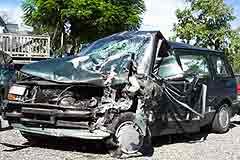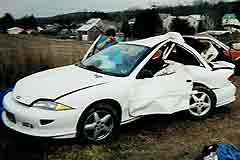You approach an intersection at the same time as an another vehicle. The other driver waves you to proceed and so you do. Then the other driver speeds up through intersection and you hit the other vehicle. When the police arrives, the driver denies ever waving you on. He or she even has a “witness” to back this up. You’ve been scammed by a staged accident.

It is estimated that staged accidents cost the insurance industry as much $20 billion a year and as much as 40 percent of insurance policy premiums go to combating, processing, and paying fraudelent claims. We all pay for these crimes, which are lucrative, low risk, and little enforced crimes, through higher insurance rates.
Those who drive new, and especially, expensive vehicles are prime targets for scammers because they know they are well covered by insurance. Another prime target are older drivers. Again they more likely to be well insured and the scammer can claim the other driver’s ability was impaired by the infirmities of advancing age. Lone drivers are more likely to covered because there are no witnesses.
Some of the other staged accident schemes to be on the look out for include:
A variation of the above scenario when the scammer is backing out a parking space, gives you a wave, an then quickly backs out so he hits you or you hit him.
A very common staged accident stop is the panic stop. Here the scammer driving in front slams on the brakes without warning and you rear end his or her vehicle.
The “swoop and squat” scam involves two vehicles. Here the vehicle in front of you is suddenly passed by another vehicles that “swoops” in front of it. The vehicle in front of you stops abruptly, or “squats.” You can’t avoid rear-ending the squat vehicle and the swoop vehicle disappears.
The “T-bone” occurs at an intersection with a stop sign or traffic light. The scammer slams into the side of your vehicle and claims that you ran the stop light or red light. Again there are “witness” to confirm his or her story.
The “sideswipe” occurs at a busy intersection with dual left turn lanes. You’re in the inside lane and you drift ever so slightly into the outer lane. The other driver accelerates and intentionally sideswipes you. The claim is that accident is your fault.
The “hit and run” occurs when the staged accident criminal uses an already damaged vehicle. The scammer calls the police to report a “hit and run” accident, then uses the police report when submitting an insurance claim.
Here are a few tips to prevent you from becoming a victim of a staged accident:
Avoid tailgating and maintain sufficient distance from the vehicle in front of you to allow sufficient time to brake if it stops suddenly
As in any vehicle accident, obtain the names, addresses, and phone numbers of witnesses and all occupants of the vehicles involved.
Call the police to the accident scene and request they complete a report.
Report accident claims to your insurance company. Don’t settle on site with cash.
Purchase a disposable camera and carry it in your glove box. Use it photograph the damaged vehicles as well as all passengers and witnesses to the accident.
Note if occupants of the other vehicle were wearing seatbelt, and even if they were actually in the car?
Be on the lookout for signs of a stage accidents. Clues include:
Was the other vehicle an old beater? Are there signs of prior damage?
Does the other drive have valid drivers license, or just a temporary one? Does the photograph match the driver? Does state of issue match the license plate state if the drivers states he is the owner?
Is the other vehicle properly registered and does the driver have current proof of insurance?
Does the other driver try to convince you not to call the police?
Does the other driver claim he or she stopped or swerved suddenly to avoid another vehicle, animal or person that no one else saw?

Staged accidents can, and often do, involve more than a chance occurrence where an dishonest individual takes advantage of an opportunity to make a quick buck. They are often include many rehearsed participants. This includes bogus witness placed near the accident to collaborate the scammer’s story and contradict yours. Other involved can include unethical attorneys who direct their clients unscrupulous medical providers who will inflates medical billing for nonexistent injuries, hard-to-dispute soft-tissue injuries.
The scammers will even hit, cut or gouge themselves to produce phony injuries. Also involved are crooked collision repair shops that will also submit greatly inflated vehicle repair bills. Finally, the crime ring will hire transients and the homeless to be the “witnesses” who will disappear and not be available for later questioning or should the case go to court.
If you suspect you have been the mark for a staged accident, report it promptly to the local police, the local FBI office or the National Insurance Crime Bureau (NICB) at (800) TEL-NICB or www.nicb.org. The NICB has investigators and analysts working with their law enforcement and insurance industry counterparts around the country to detect, prevent, and prosecute those defrauding insurance companies. Calls to the NICB can be anonymous and you could be eligible for a reward.




